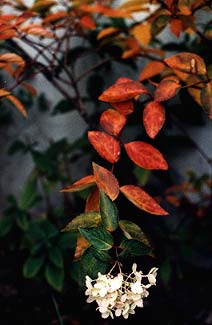
Peegee Hydrangea,
a Northwest favorite
We planted a young deciduous Peegee Hydrangea between two large shrubs, an abelia & a rhody, & have pruned the abelia away from it so that the Peegee doesn't get crowded out while it is gaining its growth. We got this little Peegee during an autumn sale at a small nursery, for an amazingly inexpensive $8 in five-gallon size. At that price it wasn't a big well-aged thick-limbed specimen such as go for ten times the price, but was tall & gangly. Sometimes finances means not every shrub obtained is already mature, & some things have to be chosen while still immature. Since Peegees do grow with startling rapidity, it doesn't require a lot of patience waiting for a small one to become a good-sized specimen.
It was at least old enough to bloom well, but being an autumn sale item, this rather wiry little four-foot Peegee was already finished blooming. Even so, it hadn't been in the ground but a couple of days before it became obvious it was going to produce one more flower despite the lateness of the year. The out-of-season panicle of buds became a bloom about half the usual size, but quite full & complete for so late. The picture above was taken in November when the Peegee had been in its place for only a month or five weeks, showing us one last bloom even while autumn colors were taking over the leaves.
This seemed an omen of great things to come for this shrub. I expect it to be very much the beauty when it has grown a while.
The name "Peegee" is derived from the initials of its species & subspecies names, H. paniculata grandiflora. It was introduced into western gardening from Japan in 1862, & has remained popular in Pacific Northwest gardens ever since. Very young plants can be a little bit sensitive in winter, but they age into an extremely cold-hardy shrub. It is hardier than the bigger-leafed H. macrophylla, hence found in gardens farther north. It also does well in the warmer southeast, though it can certainly suffer from too much heat.
Here in the Northwest they can tolerate full sun but should never entirely dry out; & they will do much better with indirect lighting or dappled sunlight. Farther south & inland they should be regarded much more strictly as shade shrubs. PeeGees are sometimes misrepresented as dwarf, but only the leaves are smaller than H. macrophylla & other popular hydrangeas. The shrub can grow into a tree if trained for that form. As trees they can be trained to grow ten to twenty feet high or taller, but it is more common to keep them pruned so that they form a five to eight foot shrub. The panicles produce gorgeous eight-inch hanging cones of richly scented florets, opening snowy-white in July & aging to a blushed pink by September. Later in Autumn when the flowers have died, they dry into a papery reddish brown & remain on the shrub well into winter.
As an aside, even though I have seen instructions for how to make Peegee blooms develop in different colors by means of soil pH manipulation, this is entirely in error. Peegees do not share this trait with H. macrophylla.
The shrub is highly amenable to being pruned to a manageable size. Older stems that have already flowered should be the first ones pruned. If not pruned it grows into a tangled mess, but can be trained into a well-formed roundish bush, or a vase-formed shrub, or as a single-trunked tree. It can certainly be let to grow wild, but bear in mind it flowers primarily on newer limbs.
Ideally it is pruned in late winter, just before spring. When left with few stems the flowers grow to their full eight inches; with more stems, the flowers are far more numerous but will be in the five to six inch range. Personally I wouldn't worry about pruning for flower size, because pruning should be done with a specific visual impact of the entire shrub in mind, given how it is so eminantly trainable.